Korean Soybean Sprout Side Dish (Kongnamul Muchim)
Korean soybean sprout side dish, called kongnamul muchim, is a classic banchan that comes together in just 10 minutes. Light and refreshing with a clean crunch, the sprouts are simply seasoned with sesame oil, Korean soup soy sauce, and garlic. A healthy make-ahead dish that pairs well with rice, soups, or bibimbap, it’s a staple you’ll always find on a Korean table.
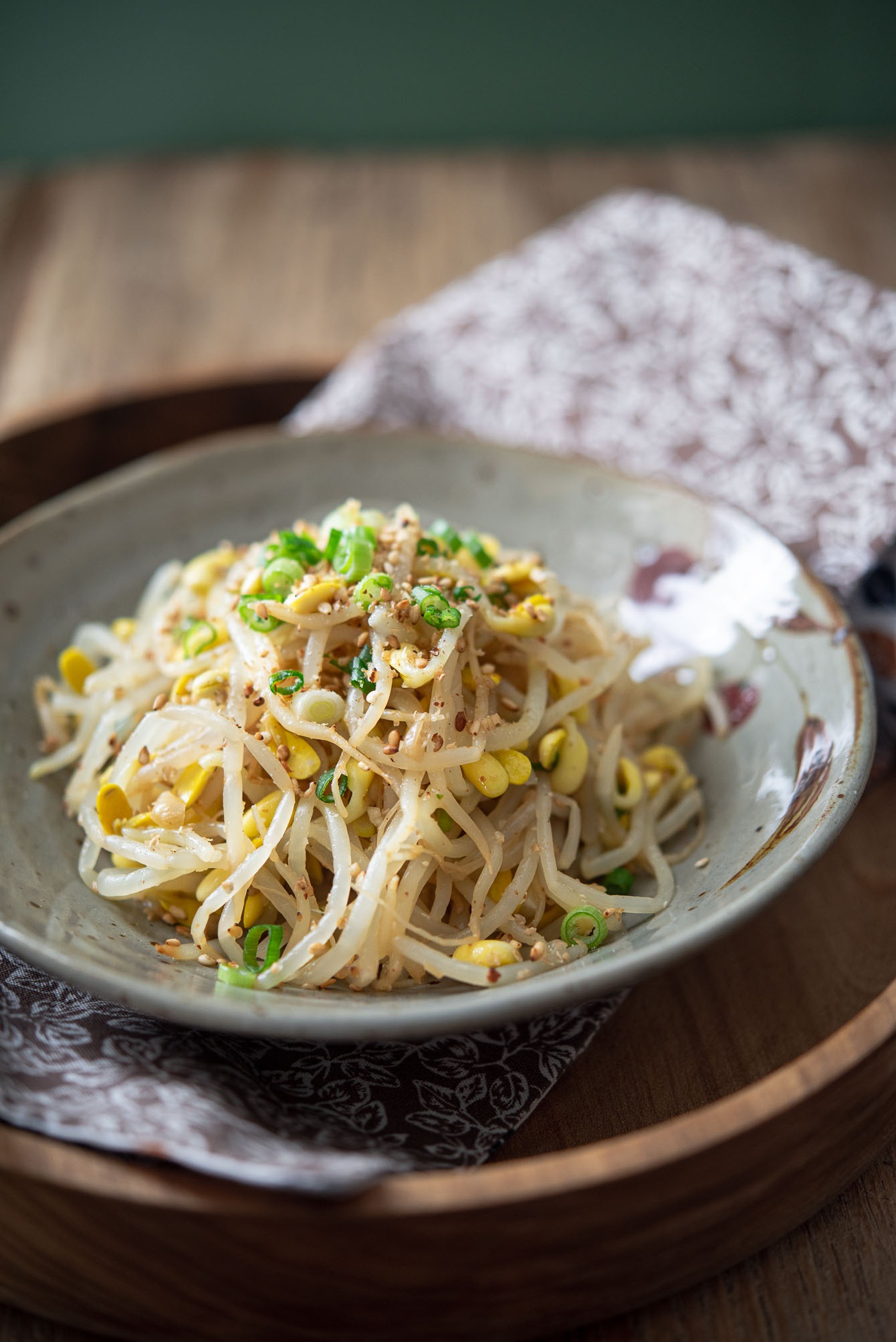
If you open a Korean fridge, you’ll often find a small container of kongnamul muchim (콩나물 무침), the classic soybean sprout side dish. It’s quick to make, light yet crunchy, and one of those dishes that fits in anywhere—next to rice, tucked into bibimbap, or served with grilled meat.
We even call it the “national banchan” in Korea because it shows up at nearly every table. For me, it was always there growing up—packed in my lunchbox, set out for family dinners, or simply enjoyed with a bowl of rice. It’s humble, but it captures what Korean home cooking is about: simple ingredients turned into something memorable.
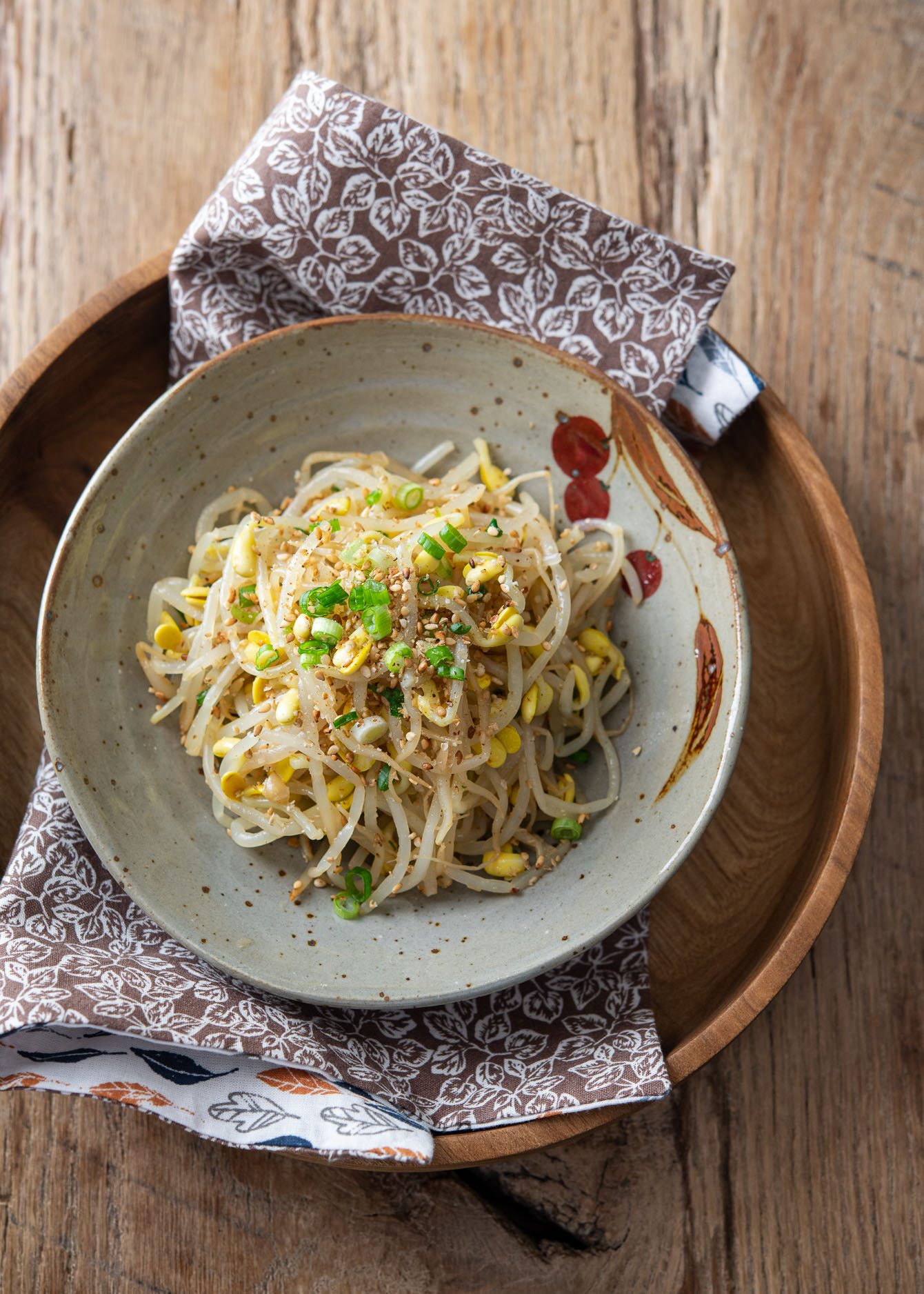
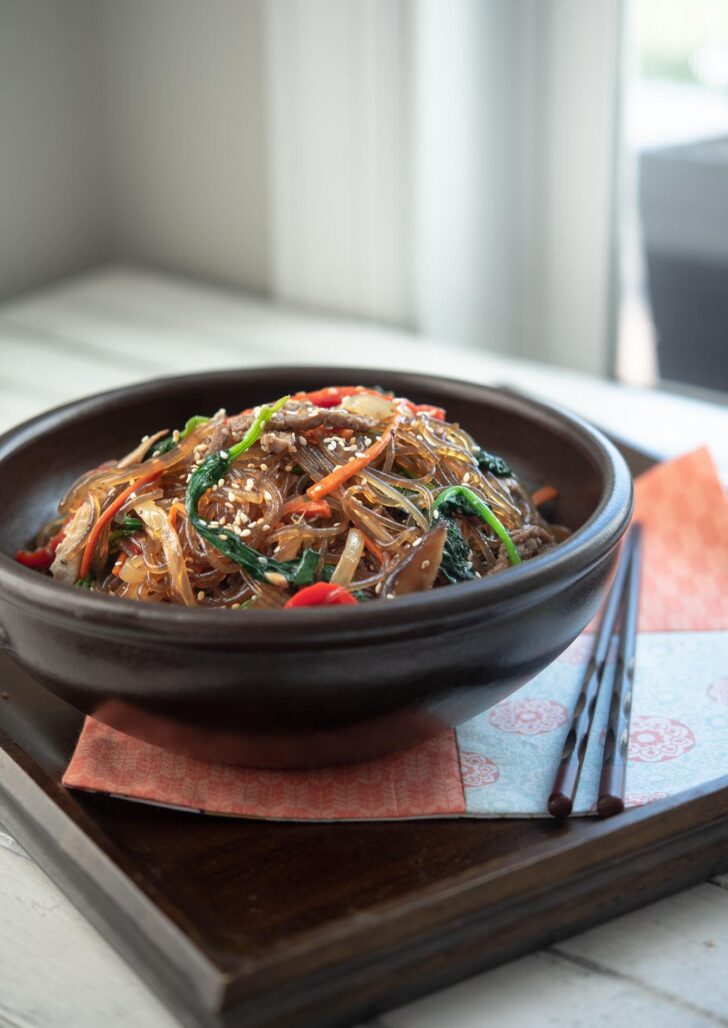
Get new recipes via email:
Why You’ll Love This Soybean Sprout Side Dish
What makes this recipe stand out is the way it’s cooked. Instead of boiling the sprouts in a pot of water, I use just a few spoonfuls. The sprouts steam in their own moisture, keeping their natural flavor and nutrition without tasting watered down. It’s a small change, but it makes a big difference.
You’ll also love it because it’s:
- Quick: ready in about 10 minutes.
- Nutritious: a good source of plant protein, fiber, and vitamins.
- Versatile: serve it as a side, add to bibimbap, or pair with grilled dishes.
- Make-ahead friendly: keeps well in the fridge for several days.
- if you like a bit of a spicy kick, you can easily transform it into a spicy bean sprout salad by adding some gochugaru (Korean red pepper flakes).
And if you’re always looking for one more banchan to round out the table, you’ll find plenty in my Korean side dish collection.
What Kind of Sprouts to Use
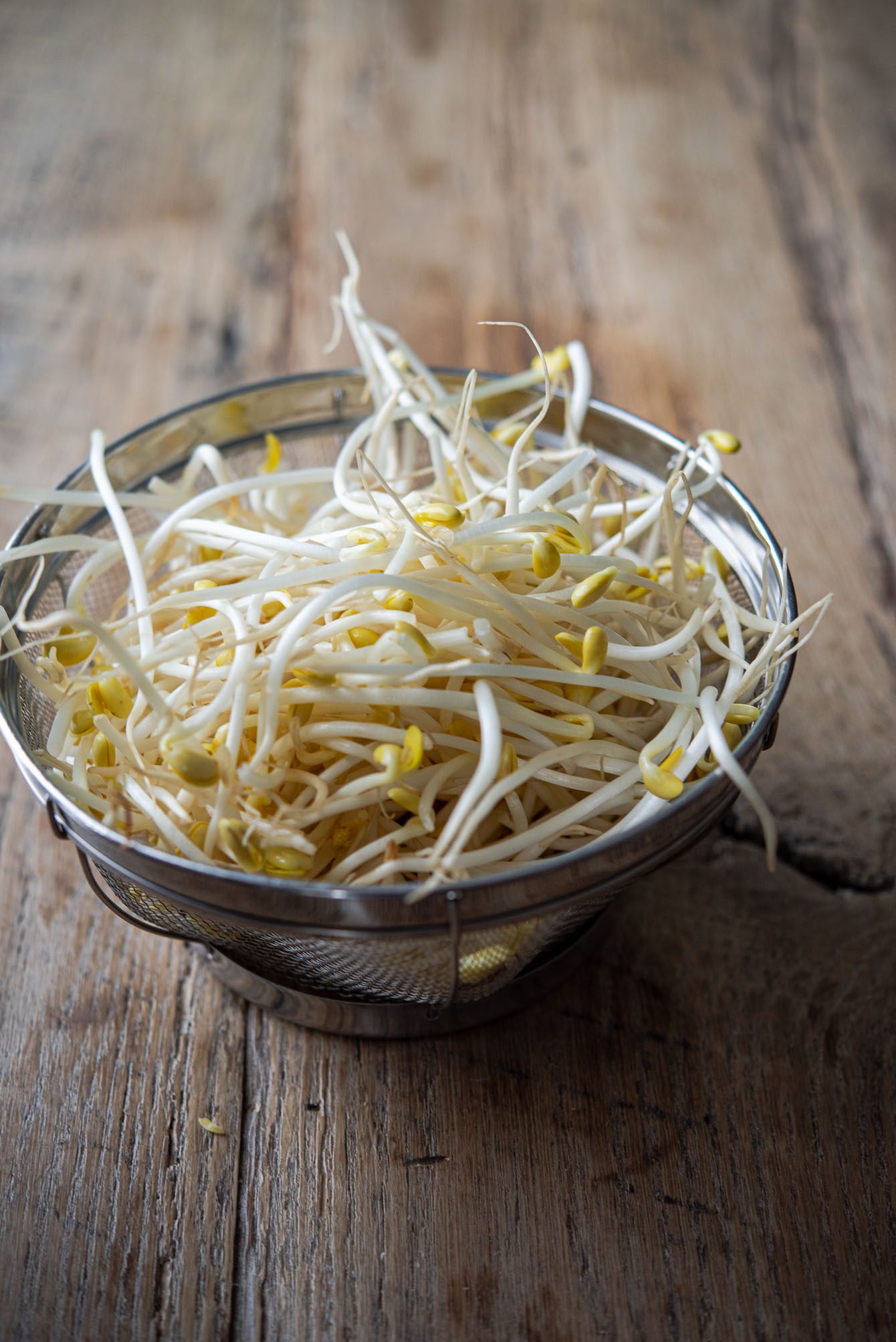
For kongnamul muchim, always use soybean sprouts.
In Korean cooking, there are two common types of sprouts: soybean sprouts (kongnamul) and mung bean sprouts (sukju namul). They look similar, but their flavor and use are quite different.
- Soybean sprouts have a yellow bean head and a nutty taste. They’re the key ingredient for kongnamul muchim, soups, and bibimbap.
- Mung bean sprouts are thinner and milder, and often added to quick stir-fries or light salads. If you’re curious, check out my mung bean sprout salad with spinach to see how mung bean sprouts are used.
How to Make Korean Bean Sprout Banchan (Kongnamul Muchim)
Cooking soybean sprouts is all about timing. Too long and they lose their crunch; too short and they taste raw. Cook them with only a splash of water so they steam gently and keep their bite. Here’s how I do it at home:
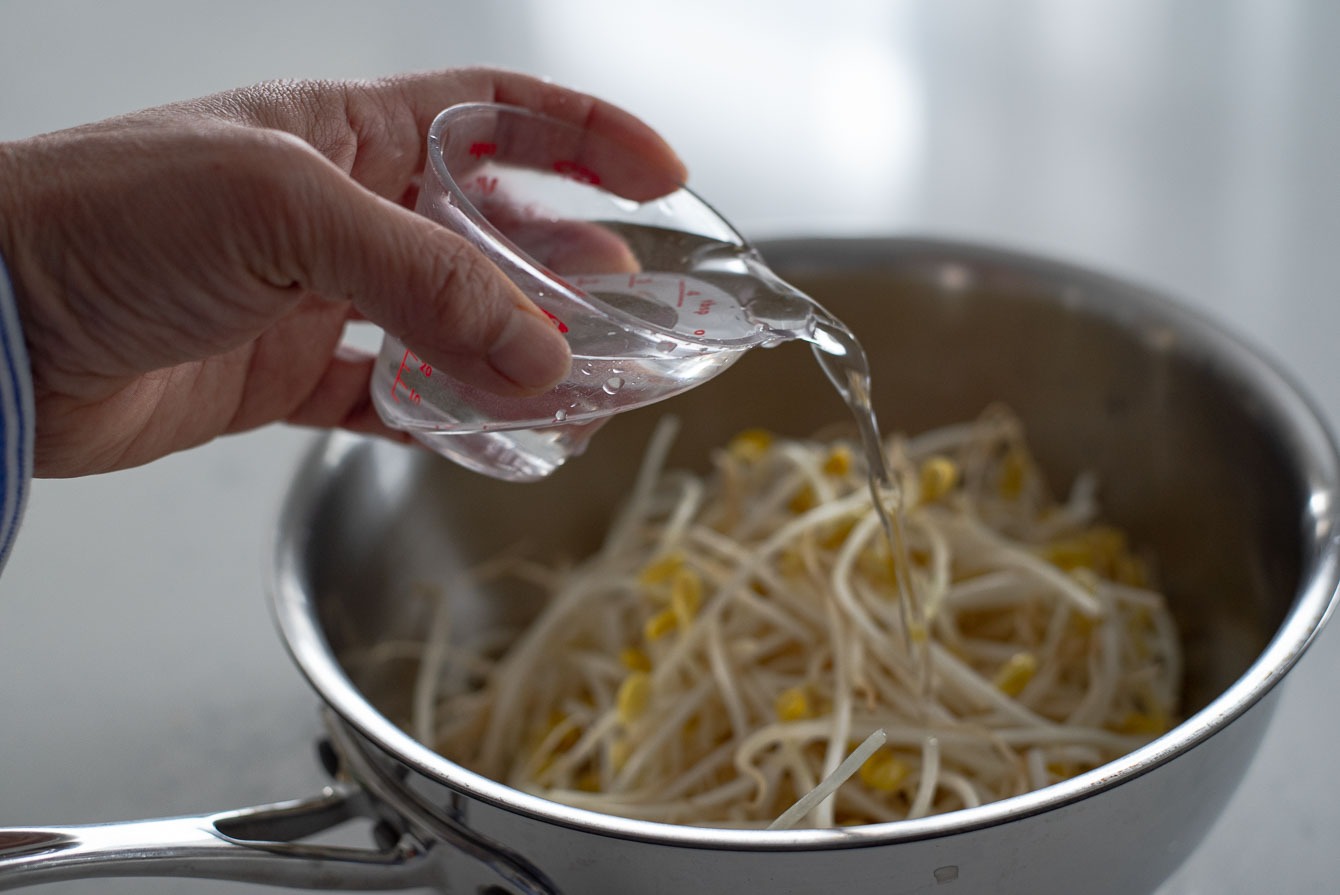
Place the rinsed soybean sprouts in a pot with only a few spoonfuls of water. Cover tightly and cook over medium heat for about 6 minutes. Don’t lift the lid while they steam—the trapped heat is what cooks them evenly.
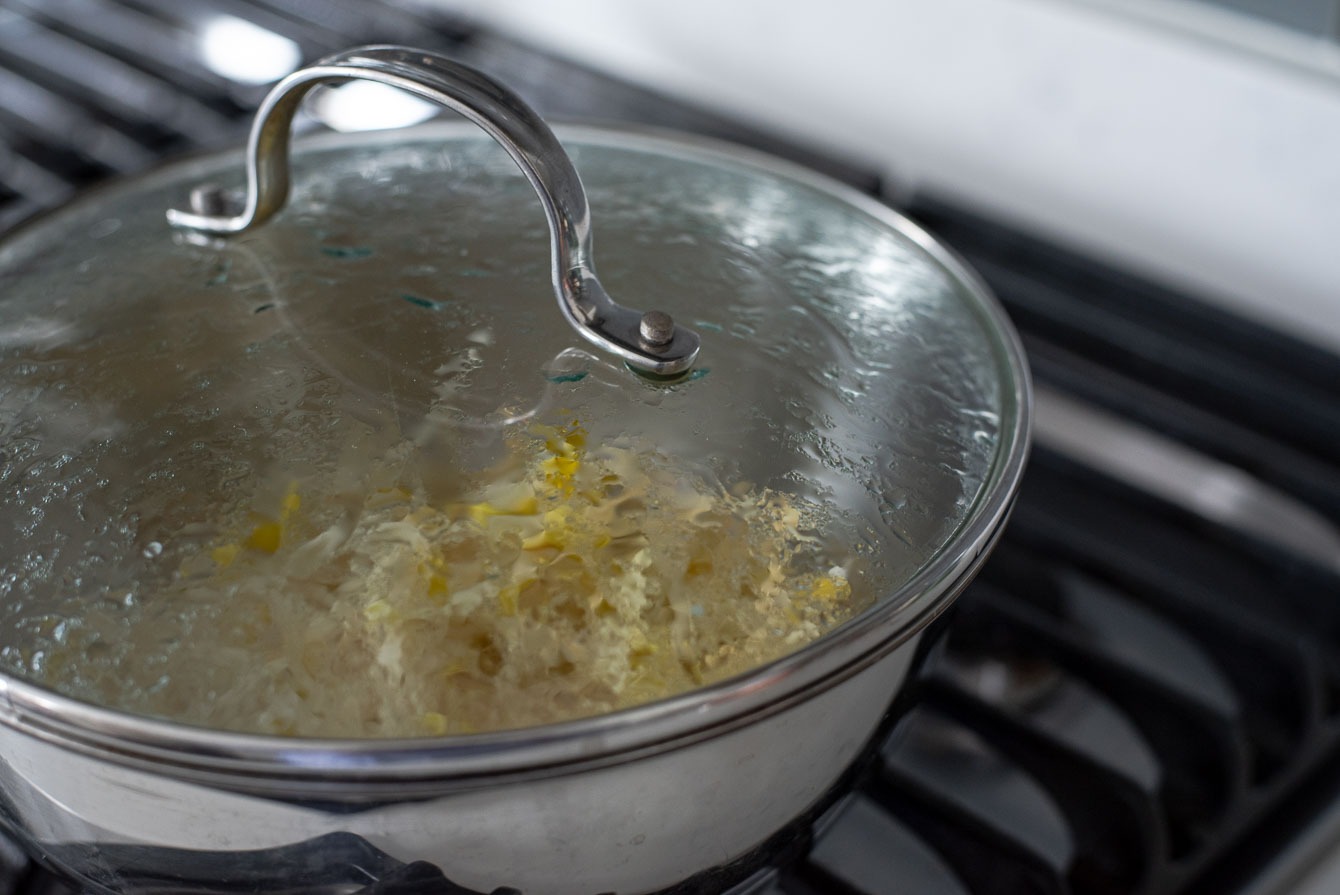
Don’t lift the lid while they steam—the trapped heat is what cooks them evenly.
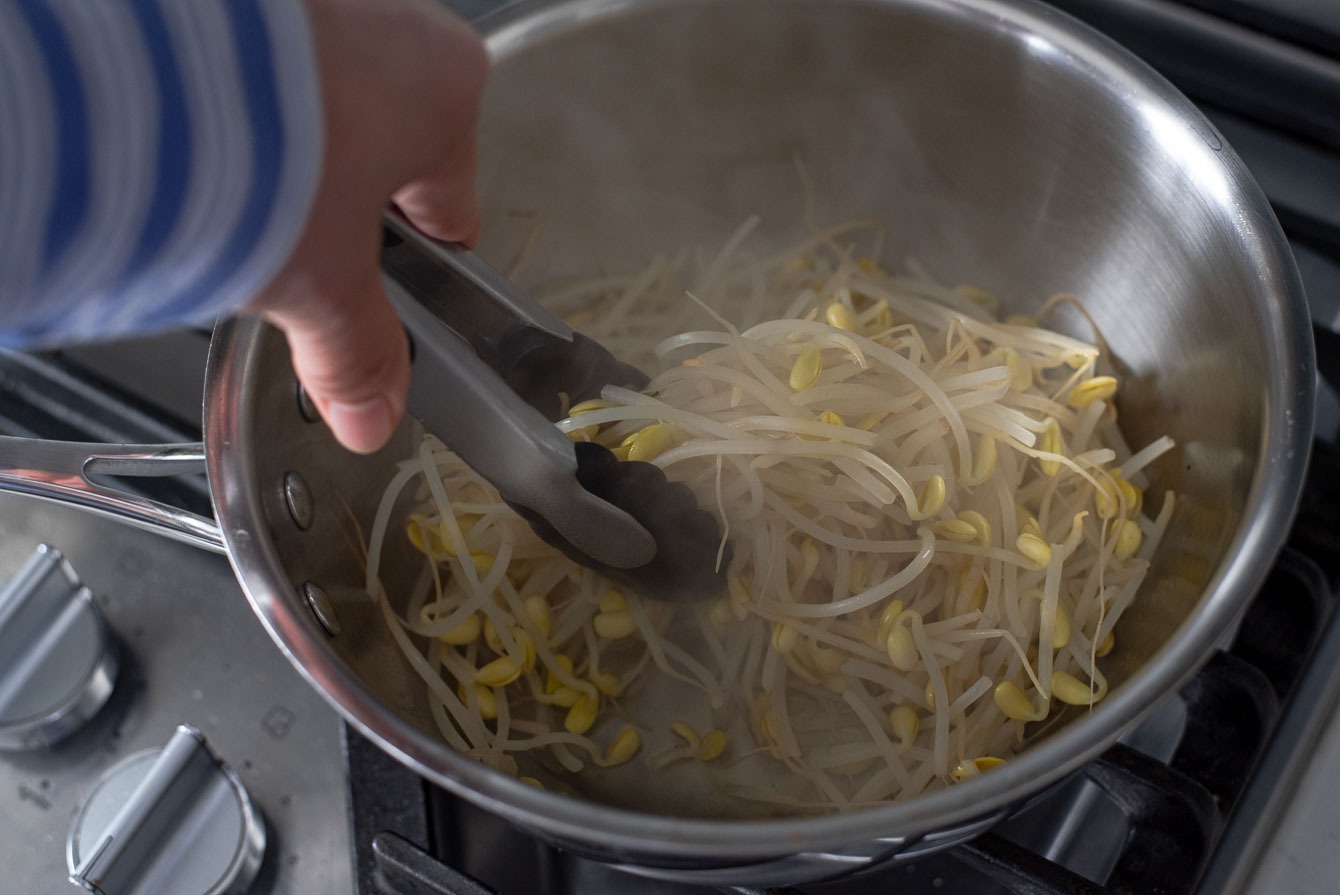
When the timer is up, stir the sprouts once, then cover again briefly. This quick step lets the residual heat finish the cooking without over-softening them.letting it sit for 30 seconds.
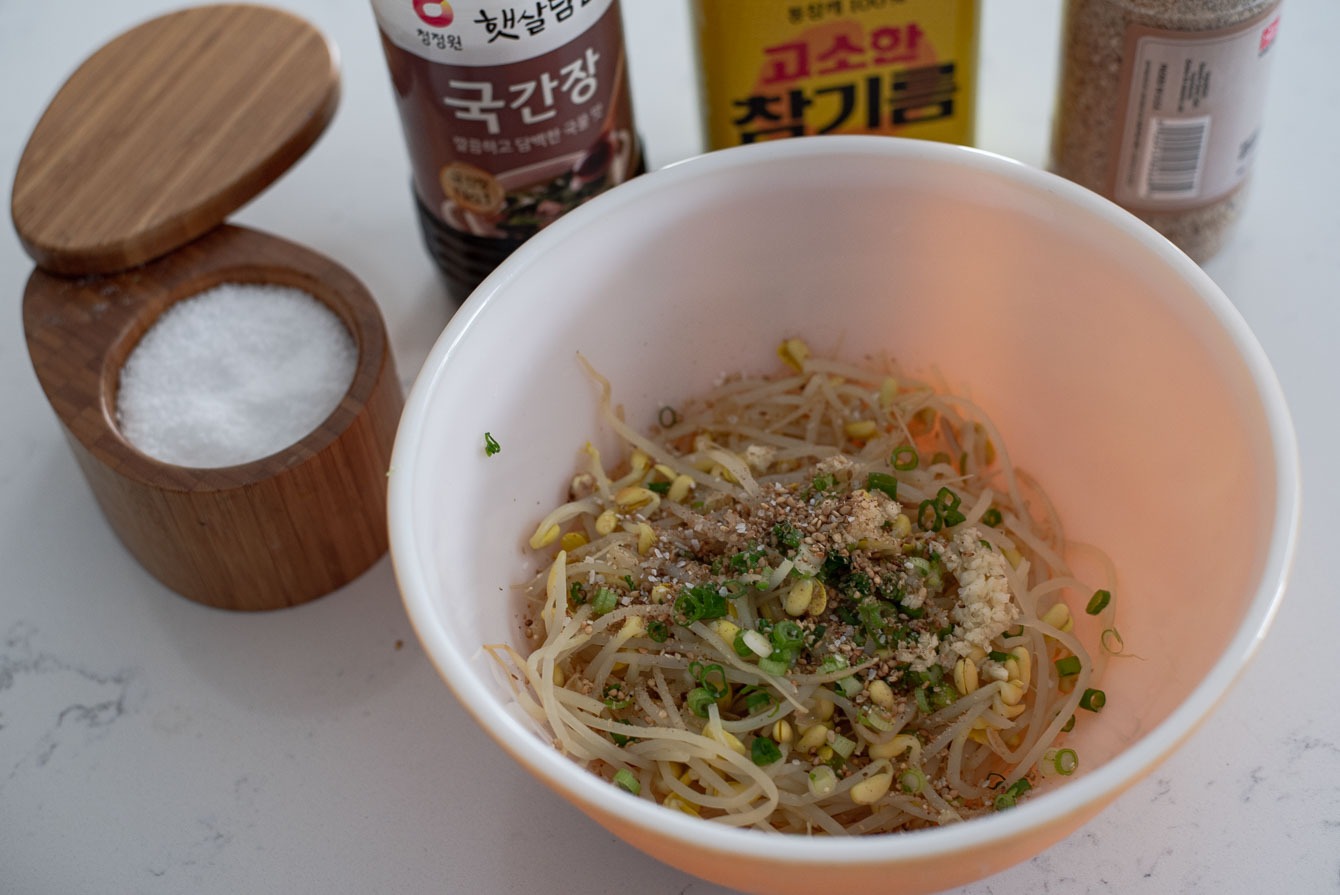
Drain the sprouts to remove the excess water and place them in a large mixing bowl. Add garlic, green onion, sesame oil, soy sauce, and sesame seeds.
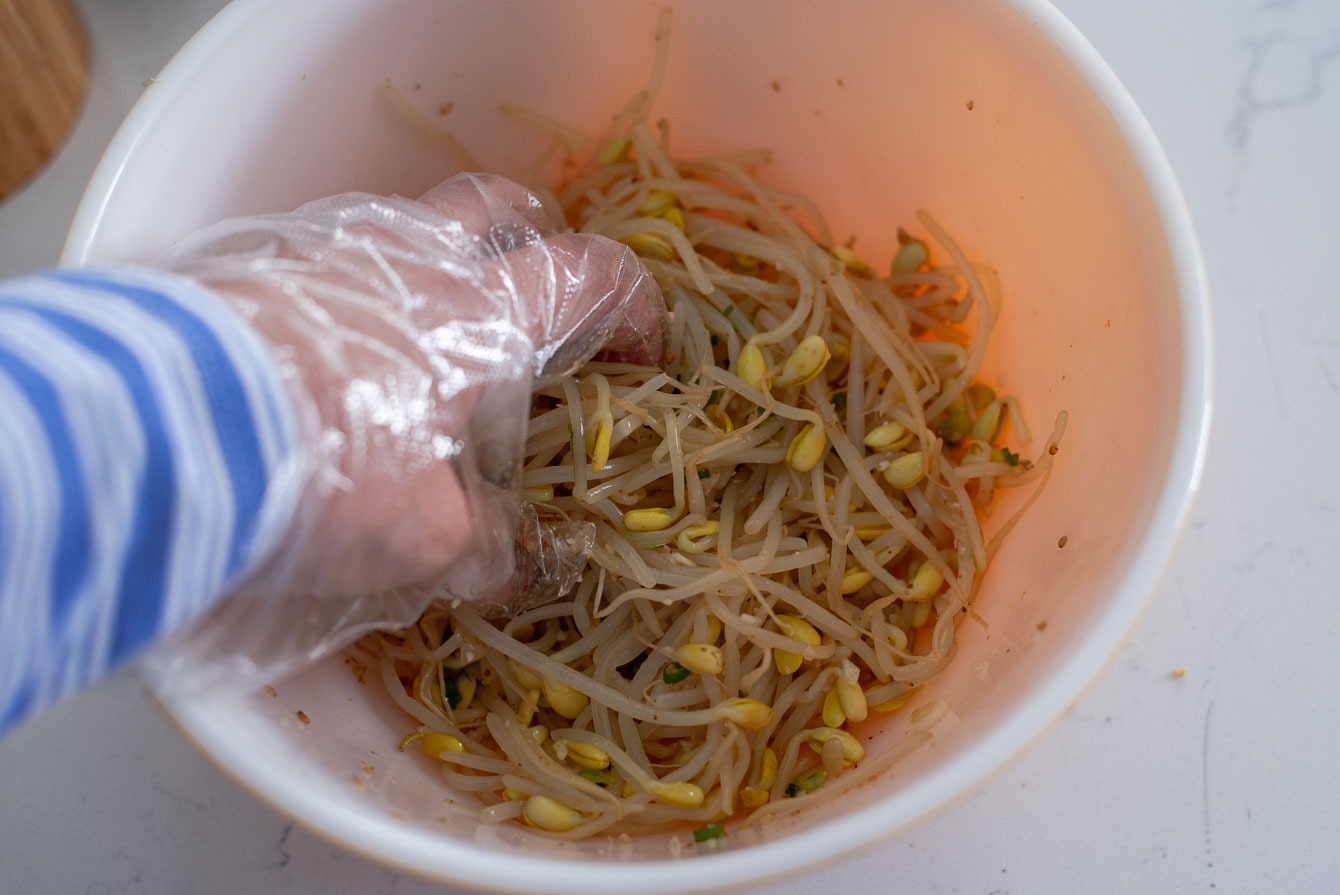
Gently toss by hand or with tongs so the sprouts don’t break. Taste and adjust the seasoning with a little extra salt if needed.
Serve the sprouts at room temperature or lightly chilled. They keep their crunch and flavor for days in the fridge, which makes them one of the easiest banchan to prepare ahead. Also it is great to use as one of topping for bibimbap
Storage
Korean families often prep several banchan ahead, and kongnamul muchim is one that keeps well. Store it in an airtight container, and it will stay fresh for 4–5 days.
Serve it straight from the fridge with rice, or add it to bibimbap. If it looks a little dry after a few days, refresh with a drizzle of sesame oil before serving.
Helpful Tips for Kongnamul Muchim
- Tails or no tails? Some Korean cooks remove the little tails from soybean sprouts for a neater look, but most home cooks—including me—skip this step. It doesn’t affect flavor, and it saves time.
- Don’t rinse after cooking. In Korean kitchens, we never rinse cooked bean sprouts. The trick is to take them off the heat just before they’re fully done. The residual steam finishes the job and keeps their natural crunch and nutty taste.
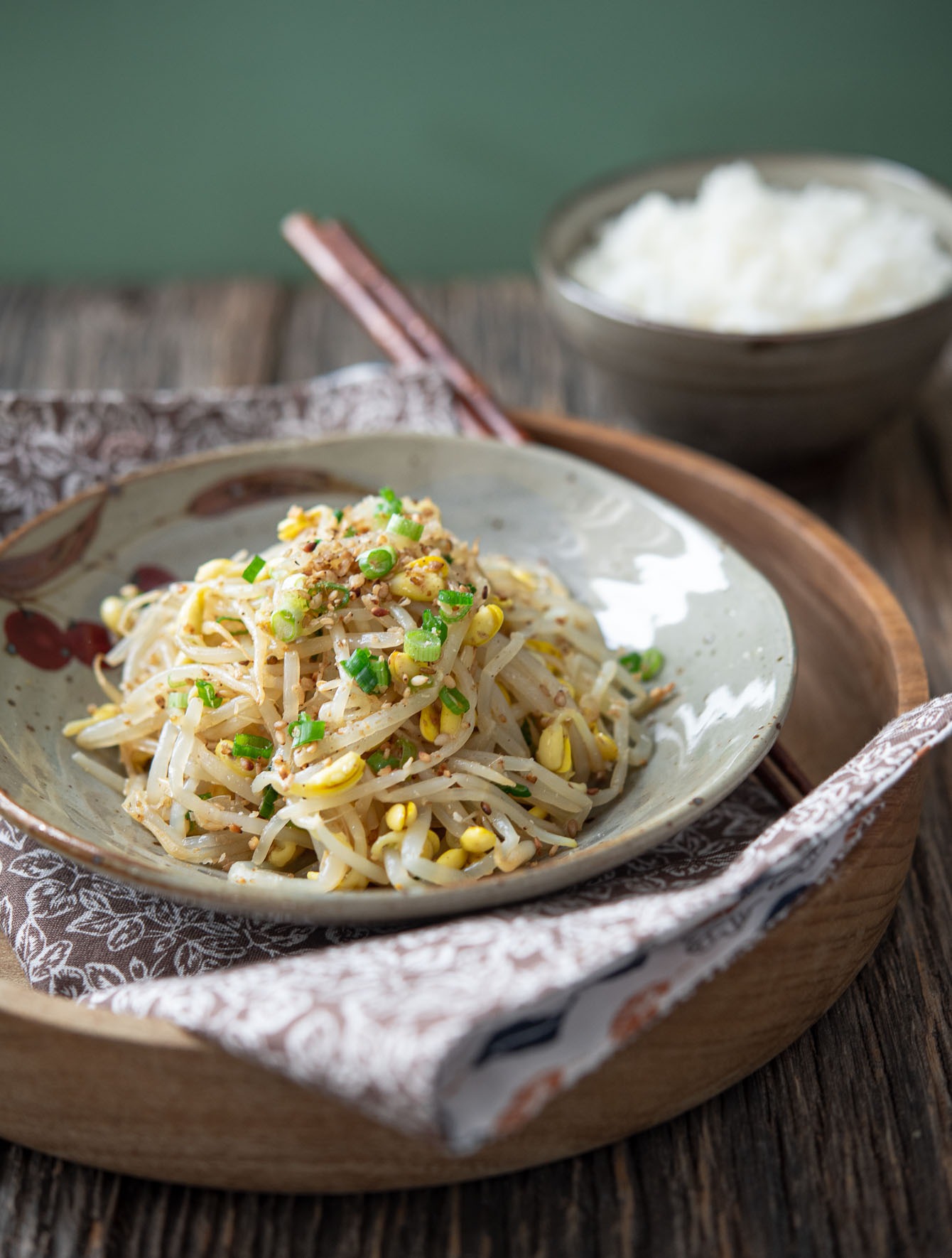
Love this recipe? Rate it and share your experience in the comments below! On Instagram? Tag me to showcase your creation. For more delicious recipes, subscribe to our newsletter!
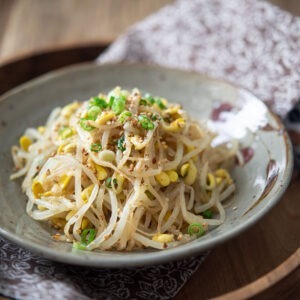
Korean Soybean Sprout Side Dish (Kongnamul Muchim)
Recipe Video
Ingredients
- 12 oz (340 g) soybean sprouts, rinsed
- 4 tbsp (60 ml) water
- 1 clove garlic, finely minced
- 1 green onion, finely chopped
- 1 tbsp (15 ml) sesame oil
- 1 tbsp (9g) toasted sesam seeds
- 2 tsp (10 ml) Korean soup soy sauce (gukganjang)
- pinch salt, as needed
Instructions
- Put sprouts in a pot and pour in 4 tablespoon of water. Close the lid tightly and let the sprouts cook over medium heat for 6 minutes. Do not open the lid. If you have a glass lid, you will see the steamed water drips down under the lid.
- Remove the pot from the heat and open the lid. Stir and turn the sprouts so that the ones on the bottom come to the top and the ones on the top end up on the bottom, and wait for 30 seconds.
- Drain the spouts in a colander to remove the extra water and let cool for a couple of minutes.
- Place the warm sprouts in a large mixing bowl. Add garlic, green onion, Korean soy soy sauce, sesame oil, toasted sesame seeds, and a pinch of salt. Toss the salad with your hand or using kitchen tongs to mix well.
- Taste the salad and add more salt if needed. Serve at room temperature or chilled.


I love Korean food and tried this recipe today. It’s soooo good!
So happy to hear that! Thank you for your comment.
Ooops! I did wonder about the instruction to steam the Bean Sprouts for 6 minutes, as I thought that sounded like a long time…I did so, but they turned out soggy and limp, and had lost their crispness, so it ruined the recipe. Next time I’ll only steam them for a couple of minutes, if that.
Since I moved from Los Angeles, where there is a huge Korean community, to a rural area where there are only just now a few Korean eating establishments popping up, I’m glad to have authentic Korean sources. I’ve been making Bulgogi for years, and I’m going to use this recipe for the Bean Sprouts tonight to go with it. I used to frequent a great Korean restaurant down south that served a lettuce salad with a wonder, light dressing. I wish I could find that recipe. Kams’hamida!
I love Korean food and don’t have a whole lot of options near me. Made this dish myself and it tasted just as delicious as the one I had in a restaurant. Tasty!
After seeing the other two sites and their recipes, I think this one reigns supreme because of the tip about steaming and using minimal water. Although, when it comes to soy sauce, many people not familiar with Asian culture, do not get the difference between Hawaiian, Korean, Chinese soy sauce, yet alone usukuchi, koikuch, tamari, soy sauce. Since, I’m a noob to Korean soy sauce, I’m not sure what “Korean soup soy sauce is.” I will have to Google it! Keep up the great work.
Hi Greg
Thanks for your comment. If you want to know more about Korean soup soy sauce, I have a pantry page on my site homepage with a collection of Korean condiments. There you will find the information about Korean soup soy sauce. Hope this helps. Thank you so much.
I like garlic but that much garlic un-cooked felt like a little bit too much for everyone. I guess 1/2 clover is ok if this is the first time you make this recipe.
This was really good and really easy. It doesn’t really stand on its own as a side, but adds a nice variation when serving a number of side dishes.
How is Korean soup soy sauce (gukganjang) different from soy sauce besides being lighter? Is it closer to white soy sauce used for lighter dishes and soups? What other uses for this? I have hundreds of different sauces and do not want to buy another one unless it is really needed.
Korean soup soy sauce is a by-product of Korean soybean paste (doenjang) and it is saltier than regular soy sauce. It also has more pungent and umami taste than regular or light soy sauce. If you like to make Korean soups and stews, and some of vegetable side dishes, (and even Korean beef bulgogi) that are asking for Korean soup soy sauce, I recommend getting one. It is hard to replace with another sauce since the flavor is so unique to Korean cuisine. For this recipe, you can skip soup soy sauce and use salt instead if you wish to, but adding soup soy sauce adds umami that salt alone can’t.
I make this salad all the time. Love it!!!! Goes with a lot of dishes.
Great! Thanks.
Hi Holly
I come from Vietnam where definitely be familiar with green bean sprout, however one day I came to KingBBQ restaurant and ate panchan made with soybean sprout. I was totally amazing that it is more crunchy and sweet. After that day I have been trying to make bean sprout with soy bean but never being successful. Hope someday you can write how to make it at home.
I loved the salad! Thank you so much for the great easy to make and delicious recipe!
Wow what a healthy little dish to serve with anything
It was a hit with all the family…now making it very often!!
thank you again
Michel
I love Korean food and I always visit your site for Korean recipes.
My family specially love the Gabi Jjim and it’s always requested when we have get together.
I want to try your side dishes, If I want to make lots of it to store (just like what I see in Korean Dramas) how long can it last good in the fridge?
Hi Tamy
The storage life of side dishes is depending on the ingredients. Fresh vegetable side dishes will last about 1 week in the fridge, cabbage kimchi will last 2-3 month (but still usable afterward), radish kimchi is about 1 month, dried goods (beans, fish, etc) are about 1 month. Salad type last just a couple of days. Kimchi-s will last fresh longer if stored in kimchi refrigerator.
Thanks for sharing your thoughts about bean sprout.
Regards
Thanks for your namul recipes! I love Korean food always wanted to try making various namul at home, but never found recipes that I like.
I shall try your recipes since they don't require too many ingredients, and are basic ingredients found in most homes.
Thanks. Let me know how you like it.
Your blog is wonderful! I'm going to follow it and try all your recipes. You're such a great cook!
I LOVE this blog! Your pictures are AMAZING! I'm bookmarking you and look forward to seeing many more recipes. I actually am making my very first attempt at sprouting bean sprouts at this very moment – I'll let you know how it goes. I love them, but don't like driving 20 miles to the nearest Korean market to buy them. I hope your recipe turns out better than the way I usually prepare them – they taste okay, but not KOREAN, if you know what I mean… I usually use dashida (I know – you're cringing as you read that!). Keep the recipes coming Holly!! You'll make a true Korean chef out of me after all!